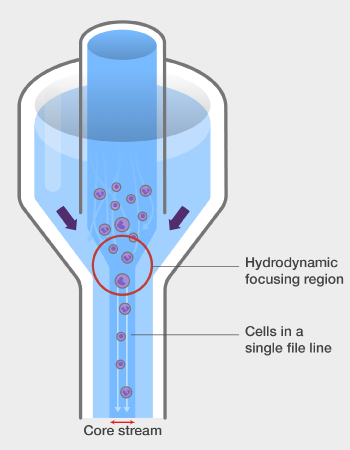Principle of the Flow Cytometry
Flow cytometry is a technology that is used to analyze the optical and fluorescence characteristics of particles as they pass through the laser beam. The cell components are fluorescently labelled and then excited by the laser to emit light at different wavelengths. The fluorescence can be measured to determine various properties of individual particles, which are usually cells. Properties measured include the particle’s relative granularity, size and fluorescence intensity as well as its internal complexity. Up to thousands of particles per second can be analyzed as they pass through the liquid stream, and an optical-to-electronic coupling system is used to record how the particle emits fluorescence and scatters incident light from the laser. Flow cytometer has numerous applications in science, including GFP expression analysis, ploidy analysis, immunophenotyping, cancer diagnosis, cell sorting, and cell counting.
Table 1. Common applications of flow cytometry.
| Field of research | Application |
| Immunophenotyping | Cancer monitoring/diagnosis |
| Monitoring AIDS/HIV progression | |
| Drug discovery | Drug resistance/uptake |
| DNA analysis | Ploidy analysis |
| Chromosome analysis and sorting | |
| Sex preselection | |
| Transgenic products in vivo | GFP expression analysis |
| Microbiology | Microbial identification |
| Bacterial viabiligy |
Components of a Flow Cytometer
The main components of flow cytometers are fluidic system, optical system (excitation and collection), and an electronic network (detectors). Additionally, a sorting device can be added to collect cells after they have run past the laser.

- Fluidic system
Flow cytometry has two sources of fluid, a sheath fluid that is usually a buffered saline, and the other is the specimen containing the cells to be analyzed. The specimen forms a core, which is injected into the middle of the sheath fluid and then pass through the flow chamber. The outer sheath fluid causes hydrodynamic focusing that compresses the specimen core into a small area. Cells are forced to pass singly through the focal point of the laser, which is crucial for collecting accurate information about each cell in the specimen.

- Optical system
Flow cytometer has an optical bench including the laser, lenses and collection optics in fixed positions.
There are many different laser configurations in flow cytometers based on the types of fluorescent dyes being excited. An argon laser, which produces blue light, is the most commonly used, although some flow cytometers and sorters add a red helium-neon laser, and occasionally a mercury arc lamp is substituted.
After the laser strikes the cells, light is deflected at the edges of the cell, also known as light scattering. There are two types of light scattering, forward scatter (FSC) and side scatter (SSC). Factors affecting total light scatter include cell membrane, nucleus, cell granularity, cell shape and surface topography. In general, the size of the cells or particles and their internal complexity determine the type of scattering. FSC light is the result of diffraction collected along the same axis as the laser beam. FCS is proportional to cell size and is suitable for detecting particles larger than a given size, making it the most commonly used method for immunephenotyping. On the other hand, SSC light is a measurement of refracted and reflected light that is collected at about 90 degrees from the laser beam. SSC is proportional to cell granularity and internal complexity as important as the fluorescent light derived from fluorescent-labeled antibodies or dyes. In order to distinguish the cell types in a heterogeneous population, relevant measurements of FCS and SSC can be used.
Collection optics consists of a set of the lens collecting emitted light from the particle-laser beam interaction and a system of filters to separate and then direct the specific wavelengths of the collected light to the appropriate optical detectors. The specificity of a particular fluorescent dye detector is determined by placing a suitable filter, which can be a long pass, a short pass and a band pass filter. Band pass filter allows only a narrow range of wavelengths, which is close to the emission peak of the fluorescent dye to reach the detector. Short pass filter transmits light having a wavelength equal to or shorter than a specified wavelength, and long pass filter transmits wavelengths of light equal to or longer than a specified wavelength.

- Electronics
Optical signals generated by particles in the fluid stream as they pass through the laser beam are converted to voltages by photo-detectors. There are two types of detectors, photodiodes (PDs) and photomultiplier tubes (PMTs), can be preferred based on their sensitivity. Furthermore, PMT’s photocathodes have the higher sensitivity than PD, although they are known to convert light into photoelectrons in a more efficient manner. Therefore, PDs detect the stronger optical signals generated by FSC, while PMTs are typically used to detect the weaker signals generated by SSC and fluorescence. The optical signals captured by PMT or PD are converted into a proportional number of electrons to generate an electrical current. After that, the electrical current is amplified by two types of amplifier, which are linear or logarithmic. The obtained analog signal must be converted into digital signal for computer processing, and then the digital data can be displayed as plots or histograms.

References
- Rowley Tom, et al.; Flow cytometry-a survey and the basics. Mater Methods, 2012, 2: 125.
- Aysun Adan, et al.; Flow cytometry: basic principles and applications. Critical Reviews in Biotechnology, 2016, 37(2): 163-176.
Cell Services:
Cell Line Testing and Assays:

